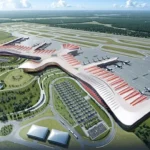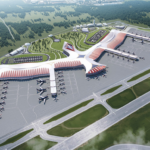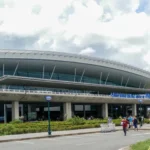Expansion of Phu Quoc International Airport: A Boost for Vietnam’s Aviation Industry
Vietnam’s Civil Aviation Authority recently announced that the government has issued a resolution on investing in the expansion of Phu Quoc International Airport. Per this resolution, the government has entrusted the People’s Committee of Kien Giang province with the task of selecting domestic investors and implementing the expansion project, ensuring it aligns with the airport’s dual civilian and military purposes.
The new passenger terminal is designed by CPG Airport, Singapore, and draws inspiration from the majestic phoenix, symbolizing royalty, power, and nobility. This design reflects the dynamic growth and international stature of Vietnam’s aviation industry. The terminal will feature advanced technologies such as online check-in and automated baggage handling systems, optimizing passenger movement and enhancing service quality.
Accompanying the new passenger terminal will be a VIP terminal, designed to receive state leaders and high-level delegations. This structure takes its cues from the mighty sea eagle, an emblem of freedom and grace in the ocean’s realm.
The Ministry of Construction has invited interested investors to proactively engage and collaborate with the People’s Committee of Kien Giang province to obtain detailed guidance on relevant procedures. Additionally, the Ministry has petitioned the Government Office to report to the Prime Minister, directing the People’s Committee of Kien Giang province to address enterprises’ proposals in accordance with legal regulations.
Prior to this development, in late January 2025, Pacific Import-Export Joint Stock Company (IPPG) proposed investing in the construction of Terminal 2 at Phu Quoc International Airport. With an initial capacity of 6 million passengers per year, the terminal could be expanded to accommodate 8 million passengers annually to meet long-term demands.
IPPG also expressed its willingness to collaborate with relevant units to research technical aspects and develop investment plans for the second runway, optimizing future operational capacity. Meanwhile, Sun Group has proposed to be the domestic investor for the project to upgrade and expand Phu Quoc International Airport as a build-operate-transfer (BOT) investor.
Sun Group suggested applying a special case investor selection method according to the Law Amending and Supplementing Laws Related to Planning, the Law on Investment in the Form of Public-Private Partnership (PPP), and the Bidding Law 2024.

A glimpse of the modern interior of the new passenger terminal at Phu Quoc International Airport.
In terms of scale, Sun Group proposed upgrading Phu Quoc Airport to a 4E-level airport with a capacity of 18-20 million passengers per year. The project includes extending the existing runway to 3,500 meters, constructing a second runway of 3,300 meters, building Terminal 2, a VIP terminal, and expanding the aircraft parking area to accommodate 70-80 aircraft.
Phu Quoc Airport Currently Serves More Passengers Than Its Capacity
Mr. Uong Viet Dung, Director of the Civil Aviation Authority of Vietnam, shared that during the 2021-2030 period, Phu Quoc International Airport is planned to continue operating the existing Terminal 1 with a capacity of approximately 4 million passengers per year. Additionally, there are plans to construct Terminal 2 to the east of Terminal 1, with an expected capacity of about 6 million passengers annually.
The Civil Aviation Authority of Vietnam noted that since its commercial operation in 2012, Phu Quoc International Airport has consistently demonstrated high passenger transport growth rates, far surpassing initial projections and ranking among the top in the country.
Therefore, the planning and investment in upgrading Phu Quoc International Airport are deemed necessary to support the region’s economic and tourism development and ensure national defense and security.
During the 2021-2030 period, Phu Quoc International Airport is envisioned to attain a 4E-level standard, catering to approximately 10 million passengers and 25,000 tons of cargo annually. The airport will be capable of handling aircraft such as the B747, B787, and A350, among others. By 2050, the airport is projected to reach a capacity of roughly 18 million passengers and 50,000 tons of cargo per year.
Constructed to 4E-level standards, the airport can accommodate large aircraft like the B747-400. During 2017-2018, the passenger terminal was expanded to accommodate 4 million passengers per year, and the apron could simultaneously handle 14 aircraft.
However, according to the Civil Aviation Authority of Vietnam’s leadership, the airport already served 3.7 million passengers in 2019, far surpassing its planned capacity. Following the COVID-19 pandemic’s downturn (2020-2021), passenger numbers swiftly rebounded, surpassing 5 million in 2022.
In 2024, Phu Quoc city welcomed nearly 6 million tourists, a rise of over 7% from the previous year, and exceeded its target by more than 170%. Presently, over 20 airlines operate more than 150 weekly flights to Phu Quoc, including scheduled and charter services, connecting the region to numerous countries and territories.
For the 2021-2030 period, with a vision towards 2050, Phu Quoc International Airport is planned as a dual-use airport for civilian and military purposes. During 2021-2030, the airport is envisioned to attain a 4E-level standard (as per the International Civil Aviation Organization – ICAO’s coding system), serving approximately 10 million passengers and 25,000 tons of cargo annually. It will be capable of accommodating aircraft like the B747, B787, and A350.
By 2050, Phu Quoc International Airport is projected to reach a capacity of approximately 18 million passengers and 50,000 tons of cargo per annum.
The Rise and Fall of Indochina Airlines: A Case Study of Vietnam’s Short-Lived, Yet Glamorous Private Airline
In 2008, a new name suddenly appeared on Vietnam’s aviation horizon: Indochina Airlines. With its sleek image, civilized message, and renowned founder, this airline quickly captured the public’s attention. However, less than a year later, the dream came to an abrupt end. The story of Indochina Airlines stands as a practical lesson in entrepreneurship within a highly challenging industry, where determination and reputation are no substitutes for managerial competence and foundational strength.
The $2.2 Million Dollar Question: Upgrading the Island Airport, Will We Choose a Domestic Investor and Create a “Made by Vietnam” Landmark?
The government has unveiled plans to expand the international airport on the island city. In a bid to boost tourism and economic growth, the resolution includes investments to enhance the airport’s capacity and infrastructure.
Expanding Phu Quoc Airport: Government Tasks Kien Giang Province to Select Investors
The Vietnamese government has entrusted the People’s Committee of Kien Giang province with a pivotal task: to select a capable domestic investor and spearhead the expansion of Phu Quoc International Airport. This project underscores the airport’s dual civilian and military significance, necessitating a meticulous and tailored approach to ensure a seamless blend of functionality and strategic requirements.














































